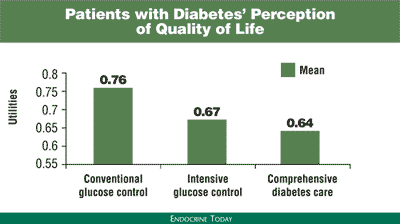Patient perceptions of complications, treatment of diabetes key to management
Recognizing patient perceptions may be important for future therapies.
Click Here to Manage Email Alerts
Findings from a study in Diabetes Care suggested that the greatest patient perceived burden on quality of life was end-stage complications, yet comprehensive treatments intended to prevent these very complications, also had negative quality of life effects.
“An important minority of patients living with diabetes perceive that the quality-of-life effects of medications are equivalent to those of many complications of diabetes,” said Elbert S. Huang, MD, MPH, assistant professor of medicine at the University of Chicago in Illinois.
“The prospect of multiple injections of insulin per day is the main driver of these negative perceptions,” he told Endocrine Today. “The use of combination oral agents was not perceived as a significant improvement in quality of life with treatments.”
From May 2004 to May 2006, Huang and colleagues interviewed 701 patients without dementia living with diabetes. The mean age of participants was 63 years; 42% were men. The investigators measured patients’ utilities (preference) using a scale of 0 (representing death) to 1 (representing perfect health.)
End-stage complications had lower mean utilities than intermediate complications. Major stroke had the lowest mean utility (0.31). Angina and diabetic nephropathy had a mean utility of 0.64, and diabetic neuropathy had a mean utility of 0.66. Diabetic retinopathy had a mean utility of 0.53, which was similar to amputation (0.55).

Intensive treatment states had lower mean utilities than conventional treatments. Intensive glucose control had the lowest mean utility (0.67). The lowest rated treatment state overall was comprehensive diabetes care (0.64). Diet (0.88) and exercise (0.89) were the highest rated treatment states.
Between 12% and 50% of patients would give up eight of 10 years in perfect health to avoid life with complications, according to investigators. Between 10% and 18% of patients would give up eight of 10 years in perfect health to avoid life with treatments.
“It is important to have frank discussions about the realities of life with diabetes medications early on,” Huang said. “Patients should know that achieving intensive control typically requires an increasing number of medications and a high probability of use of insulin.” – by Christen Haigh
Editor’s note: It is important for treating physicians to appreciate how much self-care impacts on quality of life. We know that testing and injecting several times a day are a burden, but do not generally grasp its magnitude. We need to pay attention to the fact that patient reported utility for intensive management is comparable to that of having significant diabetes complications.
– Robert D. Blank, MD, PhD
For more information:
- Huang ES, Brown SES, Ewigman BG, et al. Patient perceptions of quality of life with diabetes-related complications and treatments. Diabetes Care. 2007;30:2478-2483.
